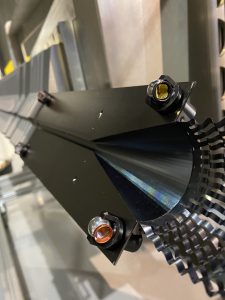 The first fixed target ever installed at the LHC is completing its way towards the mounting in LHCb, making the latter the first experiment having two different interaction points (beam-beam, beam-target) able to work simultaneously. Actually it’s a two-in-one experiment! Thanks to the LHC beam unicity, the LHCb peculiarities and the versatility of the gas target where it will be possible to inject gases such as H2, D2, N2 and O2, besides noble gases like helium and xenon, a new physics frontier at CERN is open.
The first fixed target ever installed at the LHC is completing its way towards the mounting in LHCb, making the latter the first experiment having two different interaction points (beam-beam, beam-target) able to work simultaneously. Actually it’s a two-in-one experiment! Thanks to the LHC beam unicity, the LHCb peculiarities and the versatility of the gas target where it will be possible to inject gases such as H2, D2, N2 and O2, besides noble gases like helium and xenon, a new physics frontier at CERN is open.
The system core is a storage cell which is the only object present in the LHC primary vacuum. In this way, large amounts of data will be collected by injecting minimum densities of gas such as not to significantly degrade the accelerator high vacuum and not to reduce the beam average life-time for all the experiments using beam-beam collisions. The new system, with the evocative name of SMOG2 (System for Measuring Overlap with Gas), will allow to carry out QCD and astroparticle physics studies with high precision in kinematic regions ever explored before. The collisions with the gas will occur at a center mass energy of 115 GeV for proton beams and at 72 GeV for lead beams.
With the LHC restart after the current Long Shutdown, LHCb, together with the already ambitious physics program using beam-beam collisions, with SMOG2 will push forward the knowledge of gluons, antiquarks and heavy quarks inside nucleons and nuclei, as well as spin dynamics, and will give important information both on cosmic ray physics and dark matter. Last but not least, using lead beams instead of the proton ones, the transition from ordinary matter to quark gluon plasma – a state of matter present in the early Universe – will be studied.
This interesting project was completely developed by INFN which, under the coordination of the Frascati National Laboratory LHCb group, featured the fruitful collaboration of the INFN Ferrara and INFN Florence groups.

Traduzione a cura di Camilla Paola Maglione, Ufficio Comunicazione INFN-LNF
 INFN-LNF Laboratori Nazionali di Frascati
INFN-LNF Laboratori Nazionali di Frascati